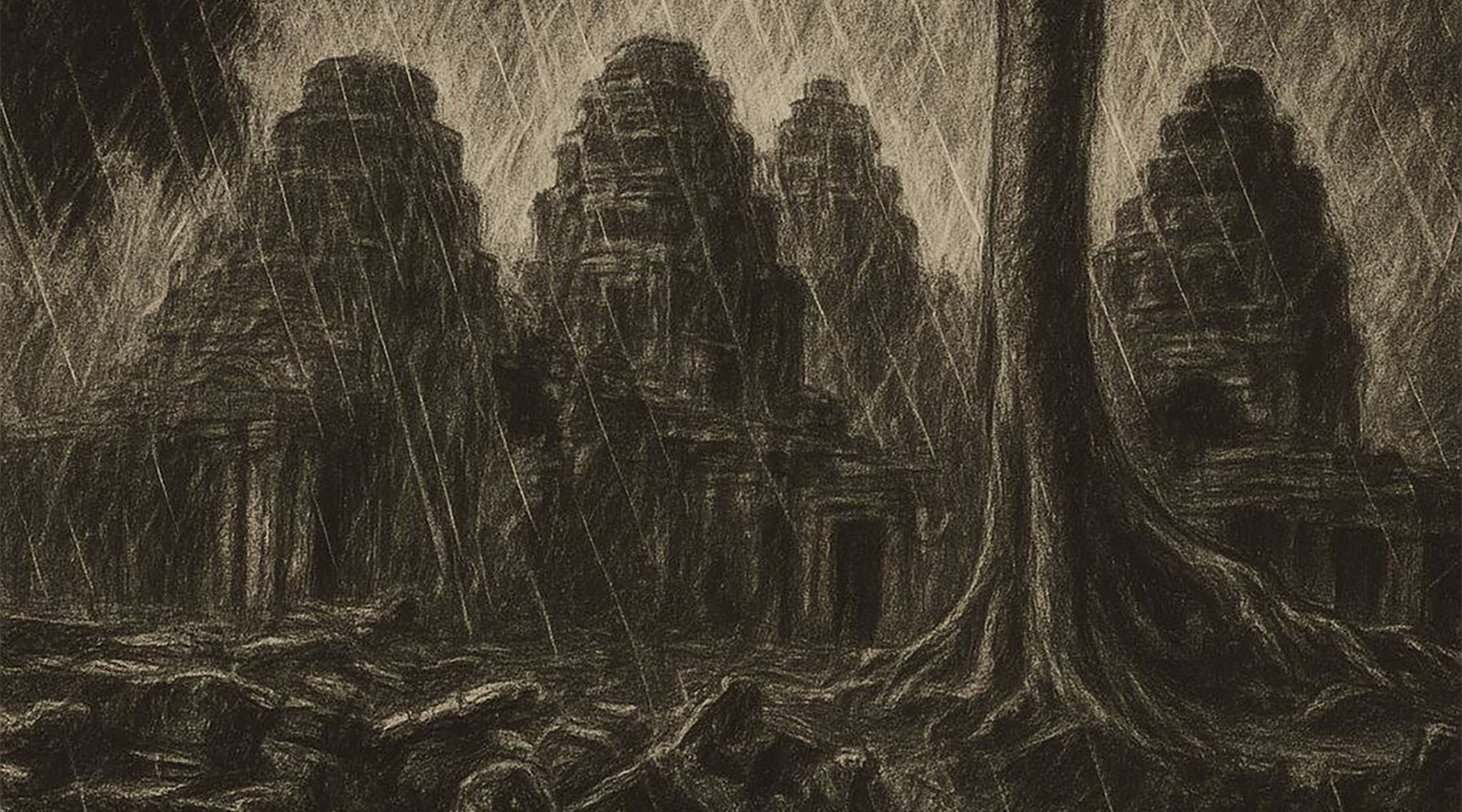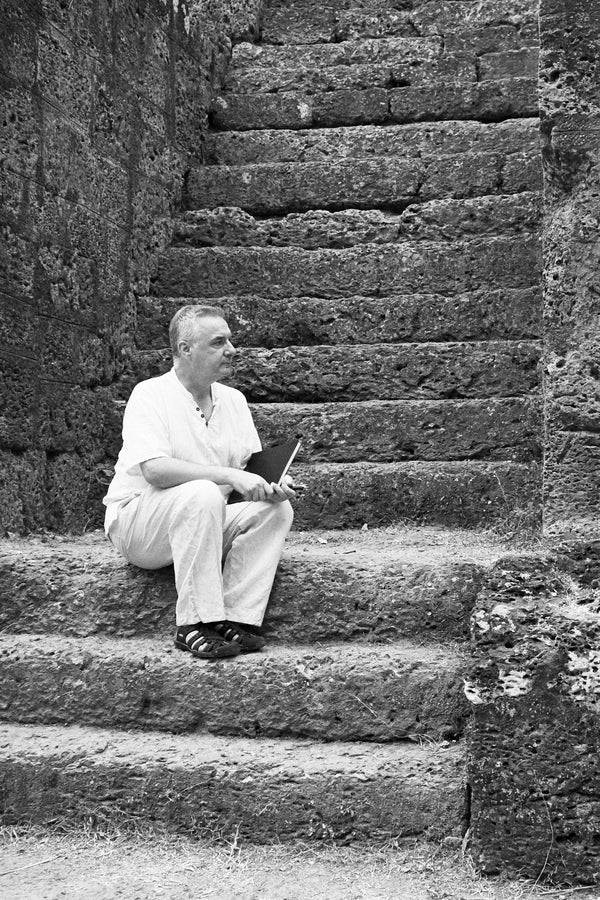Complimentary worldwide shipping on orders over $400 · No import tariffs for most countries
Complimentary worldwide shipping on orders over $400 · No import tariffs for most countries

Morning Magic in the Rain: Exploring Banteay Kdei Temple
Don’t fear the rain. In Angkor, it’s not just weather - it’s poetry!
There’s something otherworldly about ancient temples in the rain – especially in a place like Siem Reap, where the ruins of Angkor breathe with centuries of history and quiet mystery. On a recent morning, Annie and I explored Banteay Kdei under a light monsoon drizzle, and what might have seemed like a soggy inconvenience turned into one of the most atmospheric temple visits we’ve ever experienced.
Our Journey Begins
The day started early, as many temple days in Cambodia do. The skies were overcast after a night of heavy rain, and a soft gray light diffused through the humid morning air. We hopped on the moto and drove the short distance from our home in central Siem Reap just after sunrise, weaving past sleepy market stalls and fields still cloaked in mist. By the time we arrived at Banteay Kdei – less popular than its nearby cousins Ta Prohm and Angkor Wat – the rain had begun to fall again in earnest. Not a torrential downpour, but a steady curtain of fine drops, enough to turn the stone paths slick and send most tourists back toward their hotels.
A Temple to Yourself
Banteay Kdei doesn’t attract crowds the way the bigger names do, especially in the rainy season. That morning, it felt like we almost had the whole temple to ourselves. The gate – weathered and split with time – stood like a portal to another era. A single monk in orange robes walked silently along the causeway, the rain beading off his umbrella like pearls.
Stepping through the gopura (entrance pavilion), we entered a maze of worn sandstone corridors, half-collapsed galleries, and vine-draped courtyards. The sound of the rain echoed softly through the empty halls, punctuated only by the occasional chirp of birds or the rustle of a lizard disappearing into the undergrowth. Without the harsh midday sun or the noise of tour groups, every carving, every column, seemed to come alive – moistened stone glinting dark and slick, moss blooming a little brighter in the damp.

Banteay Kdei Temple - Study 2 in Chalk. 2025 by Lucas Varro
Echoes and Reflections
Banteay Kdei was built in the late 12th century during the reign of Jayavarman VII. Its outer gates have the face towers reminiscent of Bayon, and within those we find the long cruciform terraces similar to Preah Khan, but there's something gentler here – less monumental, more introspective. The rain seemed to amplify that sense of quiet reflection.
Pools of water formed in sunken courtyards, mirroring the broken lintels above. We paused at one of the central towers, watching rain drip from the mouths of ancient kalas guarding the temple’s heart. In that moment, time dissolved. It was just us, the rain, and the ruins. Annie paused and sat on a step for some quiet meditation while I sketched and took photographs.

Apsara, Banteay Kdei Temple - Study 1 in Chalk. 2025 by Lucas Varro
Why Rain Is a Gift
A visit to Angkor in the early dry season (late November to early March) is impressive, no doubt, and a lot cooler – but don’t underestimate the magic of a rainy morning. The weather softens the light, cools the air, and invites a slower pace. The temples and the jungle burst into life with vibrant greens and new growth. You don’t rush through Banteay Kdei in the rain; you linger. You notice. You feel the passage of time in the quiet crumbling of stone and the slow rhythm of water.
By mid-morning, the rain had eased. A few more visitors trickled in but we were already soaked – in the best possible way – in silence, in atmosphere, in the spell of a temple that, for a while, felt like it was ours alone.

Banteay Kdei Temple - Study 3 in Chalk. 2025 by Lucas Varro
Sanctuary of Quiet Offerings
Photographs from Banteay Kdei – Spirit of Angkor series by Lucas Varro
Banteay Kdei is a temple of worn thresholds and whispered prayers—a place where the sacred does not announce itself, but lingers softly in the shadows. Built on hallowed ground and long wrapped in silence, it is one of Angkor’s most intimate sanctuaries. Time has weathered its stones into gestures of grace, and through its fallen lintels and leaning walls, light slips in like breath through cupped hands.
In this contemplative collection from the Spirit of Angkor series, Lucas Varro returns to Banteay Kdei with the patience of a pilgrim. Each photograph was made with large or medium format black-and-white film, shaped by long exposure, chiaroscuro, and the artist’s own hand-toning process. These are not images of decay—but of devotion. Moments of stillness revealed in the company of stone.
Printed on museum-grade Hahnemühle Bamboo paper in limited editions, each work is accompanied by a Collector’s Print Package that includes poetic writings, curatorial notes, and reflections from the artist’s daily wanderings through the temple’s sacred ruin.
This is Banteay Kdei not as a monument, but as a hush—a quiet offering held open to the light.
Join My Studio Journal
Receive occasional letters from my studio in Siem Reap—offering a glimpse into my creative process, early access to new fine art prints, field notes from the temples of Angkor, exhibition announcements, and reflections on beauty, impermanence, and the spirit of place.
No noise. No clutter. Just quiet inspiration, delivered gently.
Subscribe and stay connected to the unfolding story.

Join My Studio Journal
Receive occasional letters from my studio in Siem Reap—offering a glimpse into my creative process, early access to new fine art prints, field notes from the temples of Angkor, exhibition announcements, and reflections on beauty, impermanence, and the spirit of place.
No noise. No clutter. Just quiet inspiration, delivered gently.
Subscribe and stay connected to the unfolding story.











